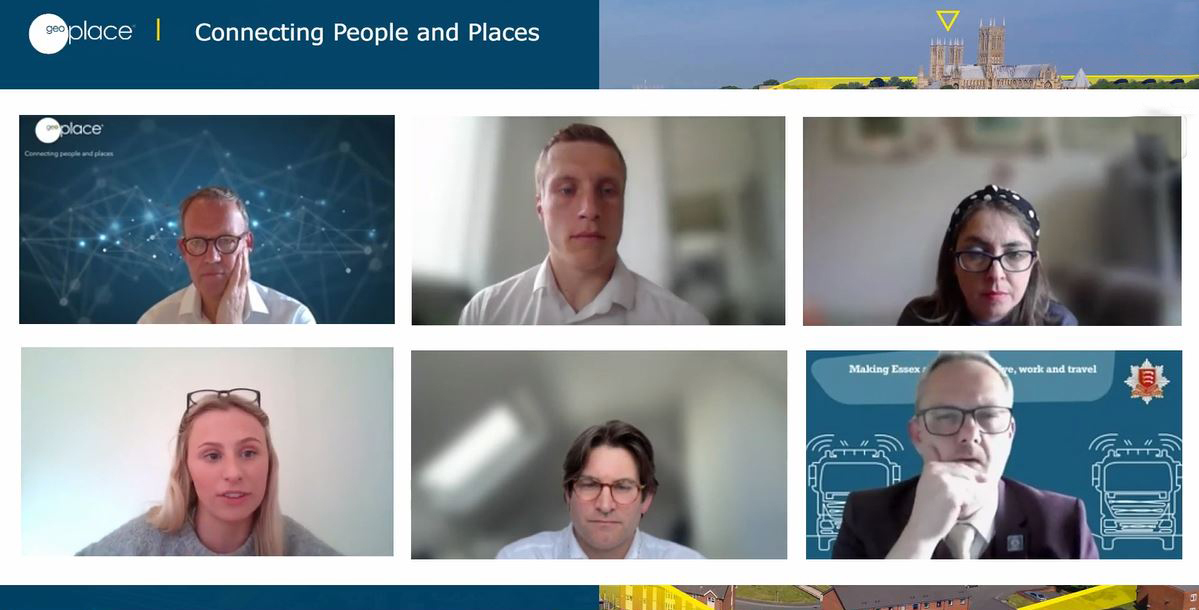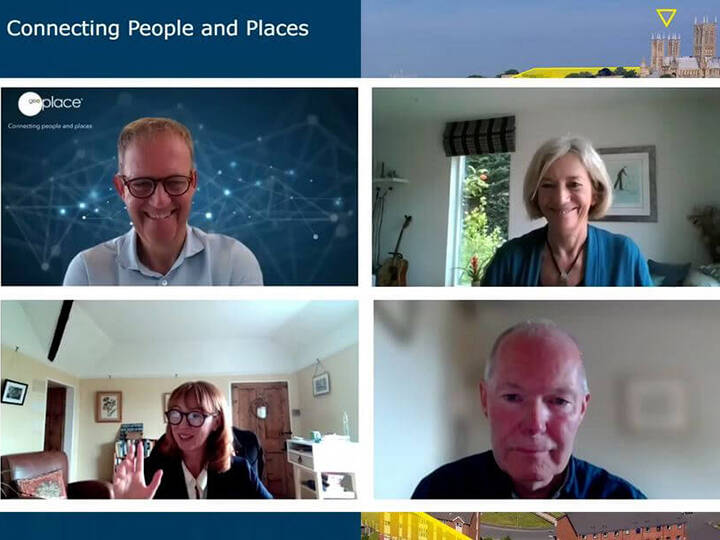At the 2022 GeoPlace annual conference, this session addressed issues around building safety in various contexts: a National Landlord Register, local authority information, the fire service, and the information that is needed to underpin building safety as a whole.
The speakers:
Exploring proposals for a National Landlord Register in England
- William Holmes, Senior Policy Advisor in the Private Rented Sector and Leasehold Directorate, Department for Levelling Up, Housing and Communities
A golden thread of information to support building safety
- Rebecca Thompson, Senior Policy Lead: Golden thread of building information (Hackitt Recommendation post Grenfell), Department for Levelling Up, Housing and Communities
- Megan Tilley, Statistician in the Buildings Safety Insights Team, Department for Levelling Up, Housing and Communities
Local authority building safety data
- Jack Ricketts, Made Tech, previously Principal Planning Officer at Southwark Council
Addressing the Fire Service
- Steve Taylor, System and Data Services Manager, Essex County Fire and Rescue Service

William Holmes, Senior Policy Advisor in the Private Rented Sector and Leasehold Directorate, Department for Levelling Up, Housing and Communities (DLUHC), started this session looking at proposals for a National Landlord Register in England.
This proposal sits within the wider aspiration to drive improvements in rented accommodation: the Renters Reform Bill should help to achieve this. The discovery phase of the DLUHC National Landlord Register involved interviews with a wide range of potential users, private tenants and diverse stakeholders across the rental landscape.
Registers of private landlords do exist already, but while they had public-facing portals for the most part, they have been disparate in nature and not universally accessible. There are over 4 million households in the rented sector. The discovery phase highlighted the value of using UPRNs in a Register as they can help reduce the risk of errors; duplication; fraud; and increase efficiencies when streamlining any service or sharing data among stakeholders. Different models of landlord registration may offer a variety of benefits, which could include but are not limited to:
- With the provision of more data about the private rented sector, local authorities will have more accurate information with which to support targeted enforcement against rogue landlords
- A national landlord register could help improve landlords’ awareness of their obligations and could be a conduit for communicating changes, ensuring landlords have access to simple up to date information about how to manage their properties
- It could also provide prospective tenants with more information about the standards of the properties they are viewing and the obligations a landlord will go to them, allowing tenants to make more informed decisions when choosing where they will live.
Rebecca Thompson, Senior Policy Lead, golden thread of building information (Hackitt Recommendation post Grenfell), and Megan Tilley, Statistician in the Buildings Safety Insights Team – both from the Department for Levelling Up, Housing and Communities (DLUHC) – introduced the next session.
Rebecca started by introducing the drivers for the government’s work on building safety. The Grenfell Fire made it clear there was a critical need for Government to drive improvements and access to accurate building data, and for that data to be clear, consistent, and interoperable. It needs to be collected cohesively – never siloed – and made widely available, to underpin an improved approach to building safety. Through the Building Safety Act, the Government is implementing a more stringent regime to strengthen oversight and protection for residents in hi-rise buildings. It gives residents a greater voice, and focusses on emerging risks that will help owners to manage their buildings better. It gives the residential building industry a clear, proportionate framework to ensure buildings are built safety, and it toughens sanctions against those who do not meet the statutory requirements.
From design through to occupation, there is a need for a ‘golden thread’ of information that helps ensure compliance to regulation. UPRNs will be a crucial part of managing the myriad datasets that will be contributing to this vast pool of information: UPRNs will enable different sources of information to be linked authoritatively in the ‘Key Building Information’ dataset.
Megan continued the session by looking at the more general backdrop to using UPRNs in DLUHC, and a specific project that DLUHC has been working on with GeoPlace.
DLUHC previously used MLCHG codes to connect data. However, it been working with GeoPlace to establishing consistent UPRNs for 92% of buildings in the Tall Buildings Dataset. This has enabled the linkage of different internal and external datasets, to establish detail about freeholders, leaseholders, remediation stats, Build Safety Fund applications etc. It has also led to greater accuracy, as visibility of change can be monitored. A longer-term plan is being developed to tackle the remaining 8% of buildings in this dataset, and DLUHC is working towards solely using UPRNs as a primary key across all the data it holds. The input from local authorities has been crucial in this work, and DLUHC is placing paramount importance on the outputs.
Jack Ricketts from Made Tech, previously Principal Planning Officer at Southwark Council, opened a segment with an overview of ways in which UPRNs can be used to improve local authority building safety data.
Immediately after the Grenfell fire, local authorities were asked to identify high-rise residential buildings that presented risks. This was challenging for Southwark Council, as it was for many other authorities. Building heights are not consistently, widely available, however Ordnance Survey does hold data that shows which buildings are over 7 stories high in the MasterMap dataset. In addition, the Environment Agency’s LIDAR data holds relevant information.
For Southwark, different departments held different pieces of the jigsaw puzzle regarding building information and residents’ details: the data was siloed, unstructured, there were no standards, the data was inaccessible – sometimes held on PDFs or in spreadsheets, on personal hard drives or even in handwritten documents. This data was constantly being diluted too, there was no version control. Also, not everyone referred to a building in the same way. ‘The Hotel on Hilltop Close’ might be recorded as 12, Hilltop Close, or 12 – 16 Hilltop Close: there was little that could be done about the very siloed nature of teams, but there was clearly room for improvement in consistency.
Jack’s team knew the key was the UPRN, but they were already stretched with day to day demand for business as usual initiatives. However, by working with Ordnance Survey, a standard methodology was created to collate information for these buildings. The vision was to create a building safety platform or portal that offered access to the right information, to the right people, at the right time. The approach involved testing assumption, conducting research, and ensuring any solution would be appropriate for other authorities, too. The team used an Agile approach: discovery, prototyping, testing, moving into beta and live states, before delivering a completed product.
Such was the importance of this work – collecting and curating information, ensuring it was linked authoritatively with the UPRN – the team’s work took a couple of months from start to finish. The result is a cloud-based solution that is easily accessible with the correct permissions; the UPRN makes it interoperable with emergency services’ and regulators’ systems; and this approach – using the unique identifier – has confirmed that the ‘golden thread’ of information is essential.
Steve Taylor, System and Data Services Manager at Essex County Fire and Rescue Service opened a session looking at ‘Addressing the Fire Service’. 24 hours a day, the emergency services revolve around accurate addressing. They need property numbering to follow best practice, and they need confidence in authoritative location information. The fire service carries out thousands of visits to conduct fire risk assessments; it runs education programmes; it attends around 20,000 callouts every year – and location data is integral to every part of this activity.
The data that flows out of the local authorities is used by the fire service in its core systems. On occasion, differences do appear in the data being used – but the integrity of the core data must be protected at all costs. Steve explained that the aspiration for many fire services is to have all of its property-related information correlated and verified, and available in one place: everything from fire risk studies that have been carried out, to event reports.
The fire service does have local knowledge it can draw on, but it relies on the accuracy of the UPRN to do its job. However, currently, the fire service has to cleanse some data to deliver the optimum services. Whenever it makes discovery, Essex Fire Service shares address change information with the local authority Custodian as soon as possible, and the aspiration is that this can become a more proactive model for all fire services – and that some UPRN classifications can become even more detailed, to assist the emergency services.
Steve concluded the session by thanking speakers and attendees alike for all their hard work, and noting that members of the location data community are involved – and possibly directly responsible – for saving lives.
Watch the recordings of this session on the Day 1 tab on the conference agenda



